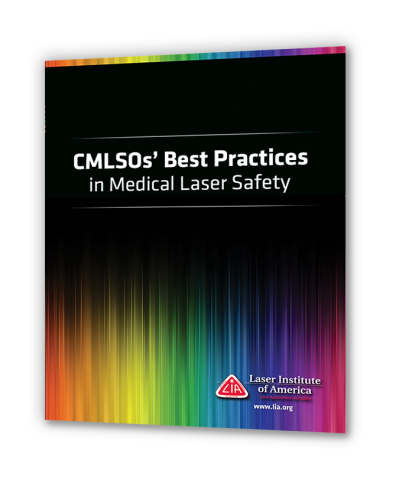

A Must Have For All Medical Laser Personnel!
Introducing LIA's New CMLSO best practices book.
Medical personnel in charge of the safe use of lasers for therapeutic procedures have a valuable new tool to help prevent harm to patients and health-care professionals. The Laser Institute of America has assembled the expert knowledge of leading certified medical laser safety officers in a new book, CMLSOs' Best Practices in Medical Laser Safety.The book compiles the latest knowledge about establishing a medical laser safety program, including laser safety regulations, how to control and evaluate such programs, and the duties of LSOs.
“Laser technology has an enormous value and keeps making a positive difference in our health care arena,” says Editor Vangie Dennis in the book’s introduction. Dennis, administrative director for Spivey Station Surgery Center outside Atlanta, asserts that “it is important to understand that regardless of the clinical setting, the presence of laser equipment creates a need for unique control measures and work practice controls to be developed and implemented.”
The 11-chapter book focuses on topics such as initial LSO duties and responsibilities, beam and non-beam hazards, and factors that determine laser-tissue interaction. The book’s contributors also address the importance of safety audits once a laser safety program has been established. Packed with useful figures and tables, the book includes samples of a medical laser safety inspection checklist, a laser inventory sheet, a laser procedure record, and laser safety audit forms.
View the Table of Contents of this publication“As addressed by the team of CMLSO authors throughout this book, the complexities of laser technology mandates the establishment of a laser safety program to ensure a safe environment for all individuals involved in laser therapy procedures,” notes editor and registered nurse Sue Terry in the book’s conclusion. “It is important for the MLSO to understand the ‘science’ behind the technology in order to anticipate potential hazards and subsequent safety measures.”
Dennis and Terry, both certified laser safety officers of the LIA affiliate organization Board of Laser Safety, stress the importance of LSO training as lasers perform roles in surgery, diagnosis, treatment, DNA research, and MRI systems. “The growing prominence of lasers in medicine is rapidly approaching the point where no physician’s education will be considered complete until their training has included some experience with basic laser physics and applications,” Dennis notes. A properly trained LSO is key to establishing a laser safety program that meets the needs of the medical facility and its culture.
Also included with this book is the CD ROM Medical Laser Safety Education Training Module. This useful PowerPoint presentation is designed for those Laser Safety Officers in Health Care environments looking for a useful tool to train all laser personnel and covers topics such as:
- How a laser works
- Power Parameters
- Bio-effects of the Laser
- Laser Safety (Patient Care, Fire Prevention, Smoke Evacuation and more…)
- Laser Systems Used in Medical Applications
LIA, the recognized industry leader in laser-safety education since 1968, offers its CMLSO book as part of a full array of cutting-edge print, multimedia, online, and classroom training resources. The book’s publication coincides with the release of the just-revised “ANSI Z136.3 Safe Use of Lasers in Health Care” standard, which defines the parameters of safe laser use in any area where a health care laser system is being used, including hospital facilities, non-hospital facilities, outpatient facilities, individual medical, dental and veterinarian offices, and non-medical locations, such as salons and spas. (114 pages)
